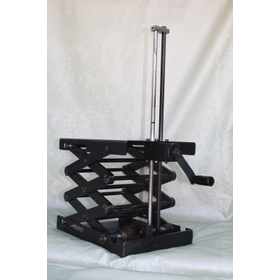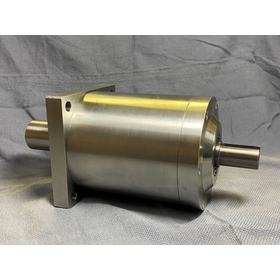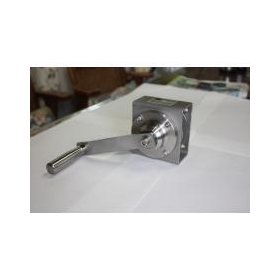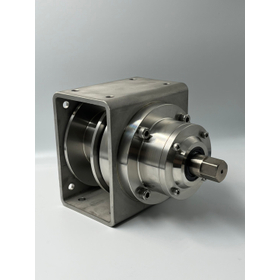Jack, rack type / no screws used, self-locking electric/manual 100 kg
Compared to screw jacks, this is a hybrid type that can be operated with commercially available electric tools due to its high speed and efficiency, and it can also be operated manually by attaching a handle.
Unlike conventional screw jacks, this rack-type jack features an overwhelmingly fast ascent and descent speed, characterized by its lightweight operability due to high efficiency. Therefore, it can be operated quickly with common electric tools (drivers/drills). Additionally, it is equipped with a unique self-locking mechanism that allows it to hold loads without brakes or stoppers, making it a revolutionary jack. Moreover, it boasts excellent strength and durability while being designed to be lightweight and compact. It also employs an omnidirectional actuator that can accommodate upward, downward, and lateral movements. It is well-suited for rack-type electric cylinders and has a rated thrust load of 100 kgf. *For more details, please visit the official website or feel free to contact us.*
basic information
Fixed thrust load of 100 kgf, advancement per rotation of 0.56 mm, input torque of approximately 0.5 Nm at maximum load, allowable input rotation speed of 1750 rpm, applicable round rack rod φ15, body weight of 1.7 kg (excluding rack). 【Features】 ○ Holds the stopping position of the rack rod. ○ Compact, lightweight, and economical. ○ Excellent strength and durability. ○ High efficiency, easy to operate both manually and electrically. ○ The reduction gear unit is maintenance-free and does not require oil changes. 【Other Features】 ○ Input shaft that holds the stopping position without a stopper. ○ Low friction and excellent durability with a micro-tooth differential compound cycloidal mechanism. ○ Simple and robust machined case. ○ All-direction actuator capable of vertical lift, push, pull, and lateral movement. ○ Equipped with Shoji lock for safety, labor-saving, and space-saving. ○ Rack-type lifting shaft that is strong against buckling and does not require a stop. ○ Reversible design that can be mounted on either side. ● For more details, please request documentation or contact us.
Price information
For more details, please contact us.
Delivery Time
Model number/Brand name
SLE-100-0.56
Applications/Examples of results
Aluminum manufacturing line Control panel cover opening and closing device Chair lifting device University experimental equipment, etc.
Line up(3)
| Model number | overview |
|---|---|
| SLE-100-0.56 | Basic type |
| SLE-100T-0.56 | Includes guide rod to cover buckling of rack rods (twin shaft type) |
| SLP-100 | Motor-driven type can also be designed |
catalog(2)
Download All CatalogsCAD data(1)
| Model number | overview | File |
|---|---|---|
| SLE-100-0.56 | Manual/Electric Tool Assist Rack Jack, Load Capacity 100 kg, Rack Rise 0.56 mm per Revolution, Reduction Ratio 93, Round Rack Φ15, Hexagonal Tip Specification. |
|
News about this product(5)
-

The second volume of the case studies for the new self-locking deceleration mechanism "shoji-lock" has been completed.
- Small winches have been adopted in shops and museums in Ginza. = They have received positive feedback for their design, being compact and unobtrusive in black. = They are also praised for being easy to operate by ourselves, among other things. Instead of a worm gear, we have developed a completely new inline reducer that self-locks when motion stops, as well as a small winch that maintains position when the handle is stopped in both forward and reverse rotation instead of using a ratchet. Due to the positive reception and increased achievements in various fields, we have created a second edition this time. Please download it and consider it!
-
We will provide an explanatory booklet: Why does it stop? The secret of the new self-locking deceleration mechanism 'shoji-lock'
A completely new inline reducer that self-locks despite being a spur gear instead of a worm gear. Why does it self-lock? What is the internal structure like? We often get asked these questions. While showing a demo unit or a cut model can help people understand, such opportunities are rare. Therefore, we created a simple explanatory document. Please take a look at this, and if you're interested, feel free to check out our specific products and contact us.
-

The Ipros version of the S-Winch/S-Linear Actuator product catalog has been updated.
This is a completely new compact winch and rack jack that self-locks regardless of where it stops in forward or reverse rotation, not using a ratchet. It has received positive feedback from various sectors, and due to the increased lineup, we have renewed it this time. Please download it and consider it! Additionally, the comprehensive catalog featuring applied products such as those with motors is available for download from our company website. Please check it out as well.
-
New product information: A new modular type of self-locking rack jack has been introduced, featuring a rack movement of 17 mm with one rotation of the input shaft.
This is the second product that combines a modular jack with a gearbox featuring a new self-locking mechanism that does not use the conventional self-locking worm gear at all. The input shaft torque is light at 1.01 kgm at 100K, and a fast advancement of 17 mm per rotation has been achieved. We propose this to customers who want to lift quickly with minimal force and aim for space-saving in various factory production lines. Additionally, it is possible to attach guide rods (twin shaft type).
-

New Product Information: Jack 50KN Manual/Electric Rack Jack with Self-Locking Function
A jack that can lift a load of 50 kN with a light manual operating force (input shaft torque of approximately 11 Nm). This jack was developed for component maintenance as an application product of the new self-locking mechanism (Shoji Lock). The body weight is 36 kg and it is made of aluminum. It is designed with a focus on lightweight and manual operability. There are two input shafts (high/low), allowing for easy switching between quickly turning the handle when there is no load and applying force when a load is present simply by changing the insertion of the handle. It can be widely used for work in locations without power, as well as for disaster preparedness and energy-saving measures. It can also be used electrically.
Recommended products
Distributors
The load-holding function equipped reduction mechanism (shoji-lock) has been developed for application products such as winches and rack jacks since the early 2000s. Steady sales activities have borne fruit, and it has begun to be adopted for various applications. Unlike conventional worm reduction gears with self-locking functions where the input and output shafts are orthogonal, our design features them in a straight line (inline), allowing for a compact design and space-saving, which has received high praise and resulted in a diverse range of practical examples. (Patents have been obtained in Japan, the United States, the EU (Germany, France, the UK), China, South Korea, and Taiwan.) Furthermore, starting in April 2023, we launched a new overseas parts procurement business, beginning with Vietnam. Currently, a majority of our parts are procured overseas, and leveraging our achievements and network, we aim to assist companies struggling with cost reduction in parts procurement.























































